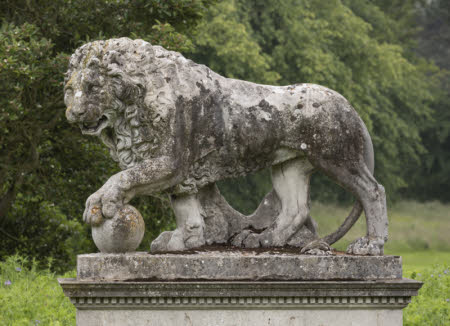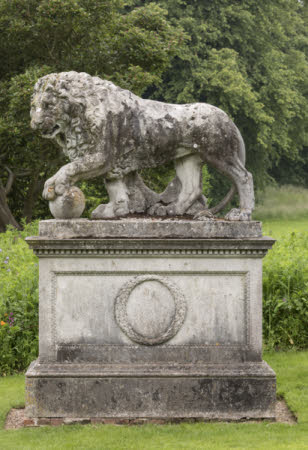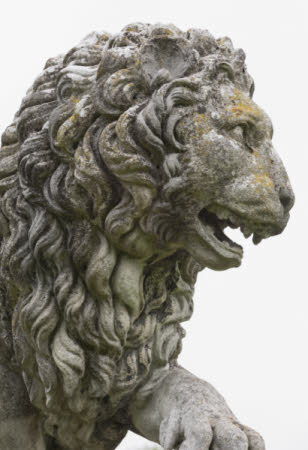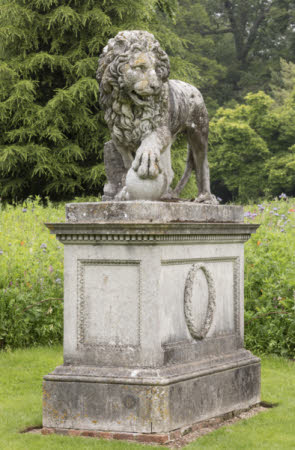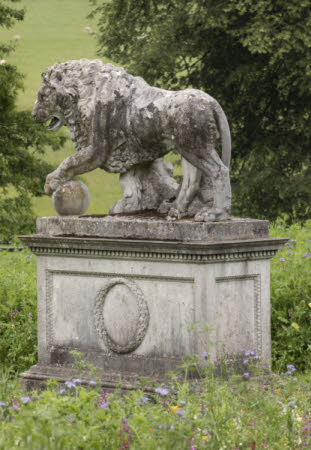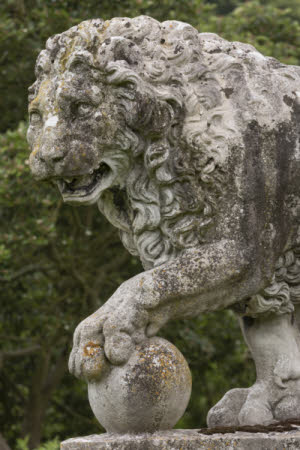The Medici Lion
Joseph Wilton (London 1722 - Wanstead 1803)
Category
Art / Sculpture
Date
1759
Materials
Portland stone
Measurements
1400 mm (H); 1570 mm (H); 990 mm (W); 2170 mm (D)
Place of origin
London
Order this imageCollection
Kedleston Hall, Derbyshire
NT 109019
Summary
Portland stone, the Medici Lion, Joseph Wilton, RA (1722-1803) after Flaminio Vacca (1538-1605), 1759. A copy by Joseph Wilton of the Medici Lion by Flaminio Vacca (1538-1605), in a pair with a 2nd century AD Roman lion, both removed to Florence in 1787 from the Villa Medici, now installed in the Loggia dei Lanzi, Florence. A male lion, prowling and roaring, with head turned to proper left and proper left paw resting on an orb. The sculpture is mounted on a pedestal designed by Samuel Wyatt (1737-1807). It was commissioned in 1759 and installed in the South Front gardens of Kedleston Hall in around 1766.
Full description
From 1751 to 1755 Joseph Wilton settled in Florence following three years in Rome where he was producing copies and casts of antique sculpture with Matthew Brettingham (1725-1803), the pair later supplying almost all the casts at Kedleston Hall. Elected to the Accademia del Disegno in 1752, Wilton's Florentine address was a house kept by Sir Horace Mann, British envoy to Rome, who praised him as an 'ingenious modest sculptor', 'admired by all the professors as well as connoisseurs'. He was popular among British Grand Tourists, many of whom became patrons, and would regularly act as a guide to the artistic collections at the Palazzo Pitti and Uffizi. In Wilton's last year in Florence he met Robert Adam (1728-92), the architect who, a few years later, would transform Kedleston Hall into the palatial neo-classical mansion it is today. The pair skated on the Arno, frozen-over in winter, Adam finding the sculptor 'sensible, civil and good-hearted' (Eustace 1997, p. 743). Wilton would continue to work with Adam on various projects, including Kedleston Hall. The Kedleston Medici Lion was carved when Wilton was back in London, almost certainly after a plaster cast taken from one of the moulds Matthew Brettingham bought back from Rome (Kenworthy-Brown 1983, pp. 82, 99, 100). From Brettingham's moulds Nathaniel Curzon (1726-1804) purchased ten casts, displayed in purpose-built niches in the Marble Hall. Wilton's Medici Lion is after Flaminio Vacca's sculpture, carved in 1594 to accompany the 2nd century lion which was excavated, according to Vacca, outside the Porta S.Lorenzo in Rome (see Haskell and Penny 1981, pp. 247-50). Fernando I de' Medici (1549-1609) bought the pair for the Villa Medici, and in 1787 they were taken to Florence and later displayed in the Loggia dei Lanzi. A receipt shows that on 2nd May 1759 Wilton received fifty guineas from Curzon to carve 'a Copy of the Medicean Lyon in Portland Stone'. Samuel Wyatt's 1765 design for its purpose-built pedestal is NT 109216. Alice Rylance-Watson February 2019
Provenance
Purchased by Nathaniel Curzon, 1st Baron Scarsdale (1726-1804), in 1759 from Joseph Wilton (see receipt dated 2 May 1759 acknowledging receipt of the sum of 'Fifty Guineas for Vallue agreed for a Copy of the Medicean Lyon in Portland Stone by me'); purchased with part of the contents of Kedleston Hall with the aid of the National Heritage Memorial Fund in 1986 when the house and park were given to the National Trust by Francis Curzon, 3rd Viscount Scarsdale (1924-2000).
Credit line
Kedleston Hall, The Scarsdale Collection (acquired with the help of the National Heritage Memorial Fund and transferred to The National Trust in 1987)
Makers and roles
Joseph Wilton (London 1722 - Wanstead 1803), sculptor after Flaminio Vacca (1538-1600), sculptor
References
Kenworthy-Browne 1983: John Kenworthy-Browne, 'Matthew Brettingham's Rome Account Book 1747-1754', The Volume of the Walpole Society, vol.49 (1983), pp.37-132, pp. 82, 99, 100 Kenworthy-Browne 1993: John Kenworthy-Browne, ‘Designing around the statues. Matthew Brettingham’s casts at Kedleston’, Apollo, April 1993, pp.248-252 Haskell and Penny 1981: Francis Haskell and Nicholas Penny, Taste and the Antique, The Lure of Classical Sculpture 1500 - 1900, New Haven and London, 1981, pp. 247-50 Eustace 1997: Katharine Eustace, ‘Robert Adam, Charles-Louis Clerisseau, Michael Rysbrack and the Hopetoun Chimneypiece’, Burlington Magazine, vol 139, Nov 1997, pp. 743-52, p. 743

